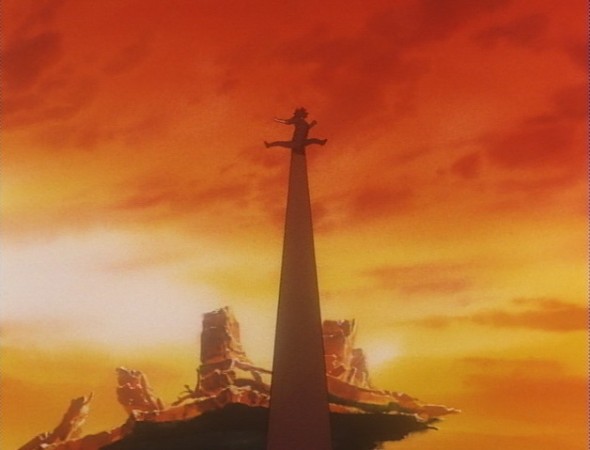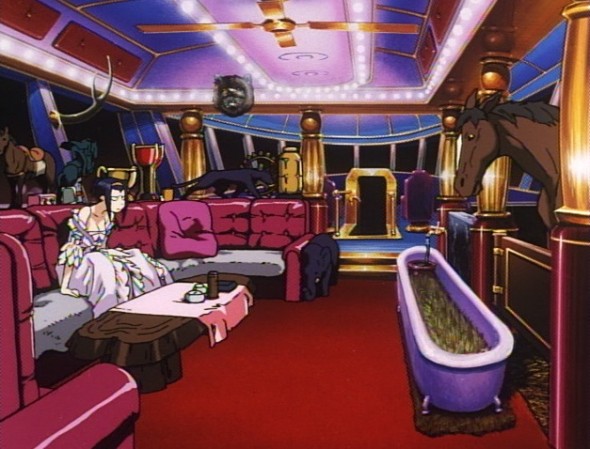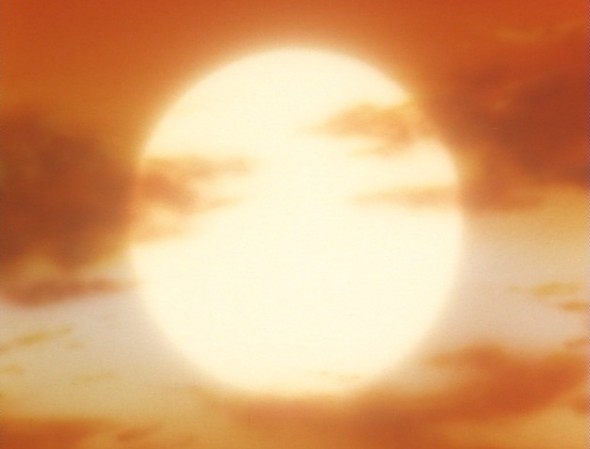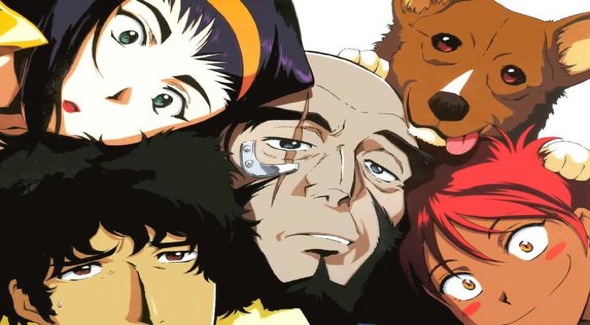
- Ball-smashing school.
Andy’s fighting style is an expression of his entire character: he’s just like Spike, but without the cool. Spike’s persona is based on the heroes of film noir, who are basically the coolest people in existence. What’s more, we are given to understand that this is not because he wants to act cool, but because it’s an expression of his truest self. Andy, on the other hand, acts like a cowboy, and not the cool, Clint Eastwood cowboy, but the lame Tom Mix kind of cowboy. (I eagerly await the hate mail of the internet’s only remaining Tom Mix fanboy. Bring it on, old-timer.) Furthermore, this is clearly and specifically revealed to us as a pose: he dresses up as a cowboy because he thinks cowboys are totally awesome! The interesting thing here? If you’re going to map good, bad, and ugly onto the main protagonists of “Cowboy Funk,” well… it’s a little tricky. Teddy Bomber is Eli Wallach. No surprises there. But if pressed, I’d have to say that Andy is probably the good, and Spike is probably the bad.
Andy is always polite and friendly (though he swears like a Cowboy too – in English – if you listen to the original Japanese soundtrack). Spike is a petulant grump, especially in this episode. Andy is fabulously wealthy. Spike is poor (and while poor is cool, it’s not something we ever really want to be). Spike never has enough food. Andy has his own line of canned soup, a corn-chowder looking concoction called Son-of-a-Gun Stew, which apparently has made him even fabulously wealthier — uh, even more fabulously wealthy. Faye brings a case of this home after spending a night at Andy’s place — we’re not totally cued in on what happened, but it seems like she considered taking him on as a sugar daddy, and then split because he was too annoying, or reminded her too much of Spike (who she secretly loves), or annoyed her in the same way that Spike annoyed her, or something.

- Or possibly because he has the worst taste in furnishings of any human being in the history of time.
There are a few interesting things going on in this episode. One is the way that Andy stands in for the good old U.S. of A., with Spike presumably standing in for Japan. I guess this is how the world sees us… maybe they hate us not so much for our freedoms as for our stupidities. Another connects back to episodes 19 and 20: like these, “Cowboy Funk” also does something interesting with the activation and resolution of mysteries. Right at the beginning, when Andy flies through the window on his horse, he cuts of Teddy Bomber in the middle of his villainous monologue where he explains the motivation for his reign of terror. Same deal for the second bombing, at the costume party. At the third bombing, Teddy tries to explain himself, and then gets tired of being interrupted and tries to kill everybody. But right at the end, he does get to give his speech – not to anyone that matters, but to a random prison guard and, crucially, the audience. Since the writers apparently thought it was worth having him say it, I’ll give you the quote here (from the subtitled version – the dub tones down the Marxism ever so slightly):
I wanted to give a warning against all the unneccessary waste created by capitalism lacking philosophy. Planets that needlessly get colonized. Media that needlessly get circulated. And buildings that are needlessly tall to symbolize all of this! And by destroying them, I wanted to raise the question of how a true pioneer should be.
Other than the awkwardness of “how a true pioneer should be,” this is interesting stuff, especially when you project it back on the episode you just watched. What Andy had, and what Spike is revealed to have (at least here, although you could argue that his behavior in this episode is a little out-of-character), is basically badassery without philosophy. They have incredible physical skills, but no reason for having those skills. Their fights, like the colonization, the circulation of media, and the skyscrapers, are needless. And neither one of them has much of a pioneer spirit: Andy’s a poseur fanboy, and Spike is a jaded scene kid. Of course, Teddy might not be much of a pioneer either. Blowing up buildings ain’t exactly making a garden in the wilderness. But it’s a pretty damning critique, the more so when you consider how much Andy can stand in for the whole aesthetic enterprise of Cowboy Bebop. That is: should we read him as American? Or as someone messing around with the remnants of American pop culture, i.e. as the show runners themselves? This gets doubly interesting when he shows up right at the end of Teddy Bomber’s speech (he tries to interrupt it again, in fact, but gets there a little too late), wearing a full Samurai outfit. After all, he only promised Spike he would stop being a cowboy, not that he would stop doing… what it is that he does. And then you remember that after Cowboy Bebop, Watanabe went on to make a similar series set in feudal Japan…

- Here, this match-on-edit is taken directly from the show. Sun…

“By the way, this awesome orange color scheme is used nowhere else in the episode. In fact, the rest of it is pretty much blue, making it the extended version of that one obnoxious high-contrast color scheme they use in every single movie poster nowadays. Bebop did it before it was lame, though.”
I hope everyone is aware of this phenomenon. It’s quite striking. For an extensive gallery of examples:
http://www.slashfilm.com/2009/11/27/orangeblue-contrast-in-movie-posters/
Ah, I knew there was a gallery somewhere! I wanted to link to it but I couldn’t remember what website it was on. Thanks for that, Lee.
Although I’d call the trend more “damning” than “striking.” :-/
I can’t add anything here but I thought I would take out space and say that these articles are awesome.
Agreed. I love these articles and am really happy whenever a new one comes out.
8 pages?? F-yeah!
It’ll be a sad day when these are finished up and the series has been overthought. :D I hope you plan on doing the movie once the series is done!
One question I have about Spike’s “massive death wish.” It could be that, but I always figured Spike as a young guy to be an adrenaline junkie. He gets his thrills from dangerous situations. Unless that’s the same as a death wish. :D
I’ll probably do something about the movie… not sure quite what, though. I’ve been thinking a lot about how one could make Cowboy Bebop into a movie (because of the threatened live-action, all-Keanu-all-the-time remake), and I’m interested in how the show’s own creative team handled it. So one thought I had was to end my posts on the show itself with a list of dos and don’ts for a cinematic adaptation, and then watch the movie and see how it stacks up against that.
As for Spike’s death wish: I think at the beginning of the series, he comes off a lot more like an adrenaline junky (especially in the first episode, where he’s not interested in fighting Solensan until he realizes that the guy is nigh-indestructible), but that as the show goes on it seems more and more like he’s actually interested in finding his death, for a bunch of quasi-existential reasons. Before he goes off to fight Pierrot he actually says something like “Maybe this will finally be the one…” doesn’t he? He tries to play it off as a joke immediately afterwards, of course, but I don’t think we’re meant to believe him. I’ll go into this more in a future post, though. You bring up an interesting question.
MASSIVE SPOILER
*
*
*
*
*
*
*
*
*
*
The entire series is about death because, as we find out in the final series of episodes, Spike’s soul has basically been dead for years, and all that is left is for him to redeem his disgraceful life and die a Samurai’s death. Which of course he does.
Although, he’s marekd for death.
But, for real, the entire series is about redemption by chosing to die a good death.
In terms of Andy’s “death of cowboy identity”, what do you make of the end title reading “See You Space Samurai”? This might make the whole thing less a death than a transformation–Andy is still just as crazy, hokey and pseudo-cool as ever, he’s just swapped the superficial stereotype he’s imitating. (And even then, the cowboy stereotype arguably has a lot in common with the samurai one; you could argue that they’re similar archetypes.)
Anyway, awesome article!
I’ll see your “less a death than a transformation” and raise you a “what is death but a transformation?” When he hands Spike the hat and walks away, you’re supposed to think that his cowboy persona is dead (go ahead and put scare quotes around that if you want to). When he shows up as the samurai at the end, I find that it reads as a resurrection, or maybe a life-after-death, which amounts to pretty much the same thing.
The similarity of the cowboy and samurai archetypes is interesting, in that actual cowboys and actual samurai are about as different from each other as two groups of people have ever been. But in pop culture, they do seem to be functionally equivalent.